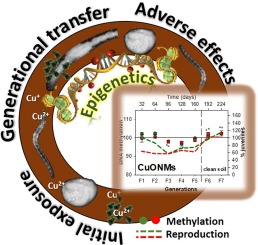当前位置:
X-MOL 学术
›
Environ. Int.
›
论文详情
Our official English website, www.x-mol.net, welcomes your
feedback! (Note: you will need to create a separate account there.)
Epigenetic effects of (nano)materials in environmental species - Cu case study in Enchytraeus crypticus.
Environment International ( IF 10.3 ) Pub Date : 2020-01-07 , DOI: 10.1016/j.envint.2019.105447 Rita C Bicho 1 , Dick Roelofs 2 , Janine Mariën 2 , Janeck J Scott-Fordsmand 3 , Mónica J B Amorim 1
Environment International ( IF 10.3 ) Pub Date : 2020-01-07 , DOI: 10.1016/j.envint.2019.105447 Rita C Bicho 1 , Dick Roelofs 2 , Janine Mariën 2 , Janeck J Scott-Fordsmand 3 , Mónica J B Amorim 1
Affiliation

|
Chemical stressors can induce epigenomic changes, i.e., changes that are transferred to the next generation, even when the stressor is removed. Literature on chemical induced epigenetic effects in environmental species is scarce. We here provide the first results on epigenetic effects caused by nanomaterials with an environmental OECD standard soil model species Enchytraeus crypticus species. We assessed the epigenetic potential in terms of global DNA methylation, gene-specific methylation via bisulfite sequencing and MS-HRM (Methylation Sensitive - High Resolution Melting), and gene expression qPCR for genes involved in DNA methylation, histone modifications, non-coding RNA and stress response mechanisms). We have exposed E. crypticus in a multigenerational (MG) test design to Cu (copper oxide nanomaterials (CuO NMs) and copper salt (CuCl2)). To link possible epigenetic effects to population changes, we used exposure concentrations (ECx) that caused a 10% and 50% reduction in the reproductive output (10% and 50% are the standards for regulatory Risk Assessment), the organisms were exposed for five consecutive generations (F1-F5) plus two generations after transferring to clean media (F5-F7), 7 generations in a total of 224 days. Results showed that MG exposure to Cu increased global DNA methylation and corresponded with phenotypic effects (reproduction). Gene expression analyses showed changes in the epigenetic, stress and detoxification gene targets, depending on the generation and Cu form, also occurring in post-exposure generations, hence indicative of transgenerational effects. There were in general clear differences between organisms exposed to different Cu-forms, hence indicate nanoparticulate-specific effects.
中文翻译:

(nano)材料在环境物种中的表观遗传学效应-隐孢子虫的Cu案例研究。
化学应激源可以诱导表观基因组变化,即,即使去除应激源,也可以将这些变化传递给下一代。在环境物种中化学诱导表观遗传效应的文献很少。我们在此提供有关由环境材料经合组织标准土壤模型物种Enchytraeus crypticus物种的纳米材料引起的表观遗传效应的第一个结果。我们根据全球DNA甲基化,通过亚硫酸氢盐测序和MS-HRM(甲基化敏感-高分辨率熔解)的基因特异性甲基化以及涉及DNA甲基化,组蛋白修饰,非编码RNA的基因表达qPCR评估了表观遗传学潜力和压力反应机制)。我们已经在多代(MG)测试设计中将隐孢子虫暴露于Cu(氧化铜纳米材料(CuO NMs)和铜盐(CuCl2))。为了将可能的表观遗传学效应与种群变化联系起来,我们使用了暴露浓度(ECx),使生殖产出降低了10%和50%(10%和50%是监管风险评估的标准),生物体暴露了5种连续几代(F1-F5)加转移到干净介质(F5-F7)中的第二代,总共224天为7代。结果表明,MG暴露于Cu会增加整体DNA甲基化,并与表型效应(繁殖)相对应。基因表达分析显示,表观遗传,应激和解毒基因靶标的变化取决于代和铜的形式,也发生在暴露后的代中,因此表明了跨代效应。一般而言,暴露于不同铜形式的生物之间存在明显的差异,
更新日期:2020-01-08
中文翻译:

(nano)材料在环境物种中的表观遗传学效应-隐孢子虫的Cu案例研究。
化学应激源可以诱导表观基因组变化,即,即使去除应激源,也可以将这些变化传递给下一代。在环境物种中化学诱导表观遗传效应的文献很少。我们在此提供有关由环境材料经合组织标准土壤模型物种Enchytraeus crypticus物种的纳米材料引起的表观遗传效应的第一个结果。我们根据全球DNA甲基化,通过亚硫酸氢盐测序和MS-HRM(甲基化敏感-高分辨率熔解)的基因特异性甲基化以及涉及DNA甲基化,组蛋白修饰,非编码RNA的基因表达qPCR评估了表观遗传学潜力和压力反应机制)。我们已经在多代(MG)测试设计中将隐孢子虫暴露于Cu(氧化铜纳米材料(CuO NMs)和铜盐(CuCl2))。为了将可能的表观遗传学效应与种群变化联系起来,我们使用了暴露浓度(ECx),使生殖产出降低了10%和50%(10%和50%是监管风险评估的标准),生物体暴露了5种连续几代(F1-F5)加转移到干净介质(F5-F7)中的第二代,总共224天为7代。结果表明,MG暴露于Cu会增加整体DNA甲基化,并与表型效应(繁殖)相对应。基因表达分析显示,表观遗传,应激和解毒基因靶标的变化取决于代和铜的形式,也发生在暴露后的代中,因此表明了跨代效应。一般而言,暴露于不同铜形式的生物之间存在明显的差异,











































 京公网安备 11010802027423号
京公网安备 11010802027423号